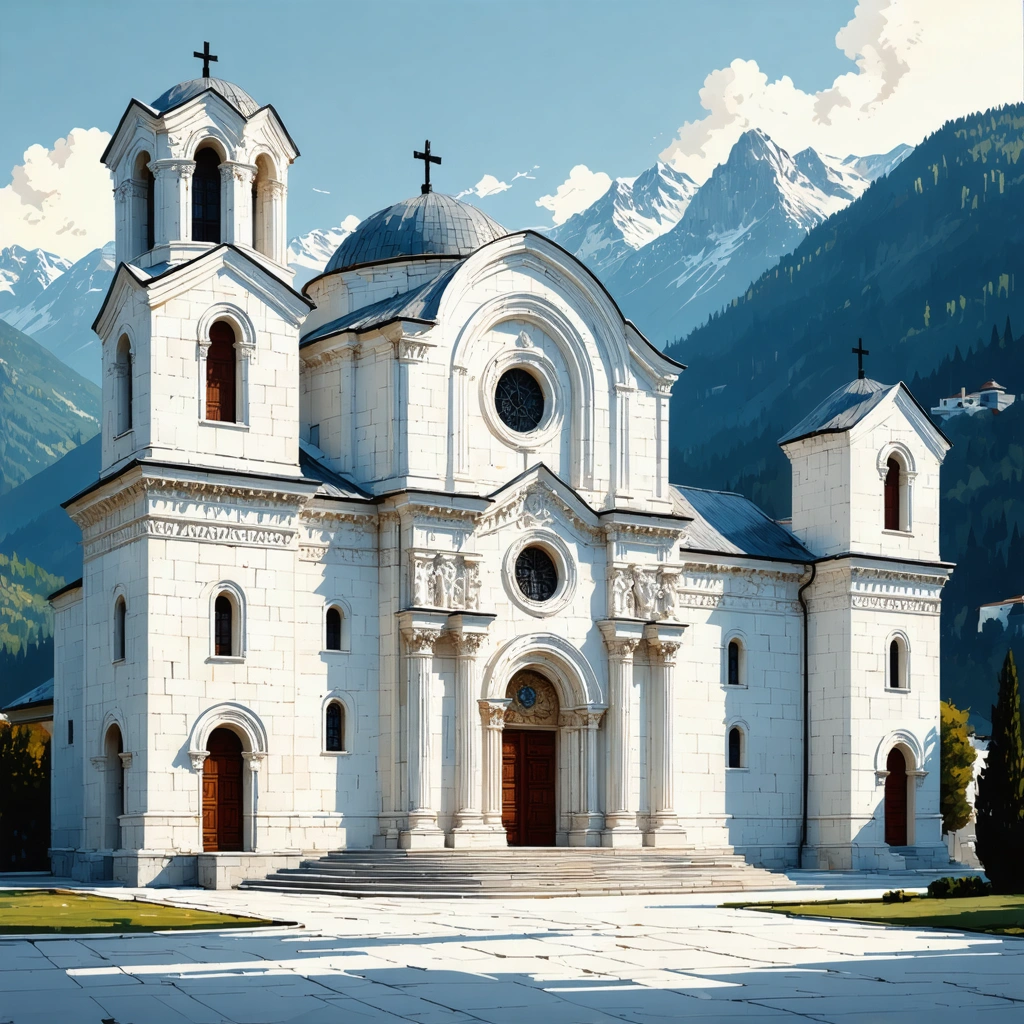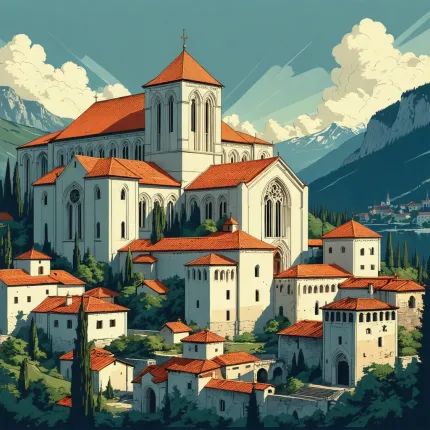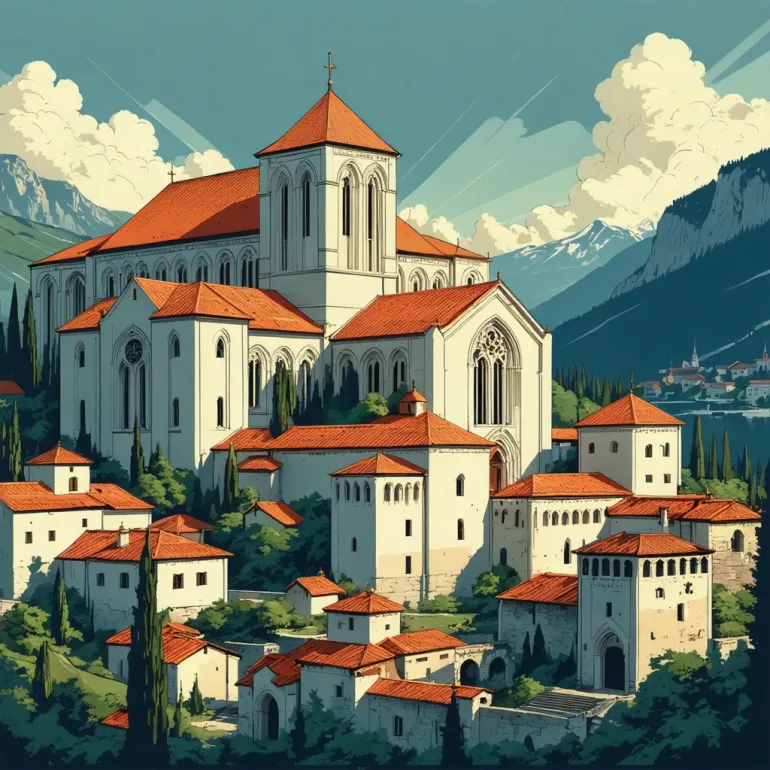Unveiling the Mystique of Serbia’s Sacred Heritage
Imagine stepping into a place where centuries of history whisper through stone walls, where the flicker of candlelight dances upon ancient frescoes, and where spirituality and culture intertwine in a timeless embrace. This is the world of Serbian monasteries—monumental testaments to faith, artistry, and resilience that have shaped not only religious life but also the very identity of a nation. Yet, despite their profound significance, many of these sacred sanctuaries remain hidden gems, overshadowed by more commercialized tourist attractions or simply unknown to those outside the region.
Take, for example, the awe-inspiring Manastir Studenica, often described as the crown jewel of Serbian medieval architecture. Founded in the 12th century by Stefan Nemanja, it stands as a beacon of Orthodoxy and Serbian culture. Similarly, the Krusedol Manastir, nestled in the fertile plains of Fruška Gora, holds stories of royal patronage and artistic brilliance that echo through its hallowed halls. Then there’s Manastir Manasija, a fortress-like monastery with imposing walls that guarded not just faith but the very survival of Serbian medieval statehood.
But why do these monasteries matter today? In a rapidly changing world where cultural heritage often competes with modern distractions, the spiritual and historical value of manastiri u Srbiji offers more than aesthetic admiration—it offers a connection to roots, identity, and a deeper understanding of resilience through adversity. Yet, many travelers struggle to appreciate the layers of meaning embedded in these sites beyond their picturesque facades. Without context, the true stories behind manastir Sopocani or manastir Krusedol risk fading into mere stopovers on a tourist itinerary, rather than living monuments to a rich spiritual legacy.
Why Serbian Monasteries Are More Than Just Old Buildings
Serbian monasteries are not simply relics of the past; they are vibrant chapters of an ongoing story. Each monastery embodies a unique blend of religious devotion, artistic achievement, and historical significance. But understanding this requires peeling back layers—layers that many visitors may miss without guidance.
Consider the intricacies of the frescoes found in Manastir Sopocani. These masterpieces of Byzantine art do more than decorate—they communicate theological ideas, historical narratives, and cultural values that have survived invasions, wars, and political upheavals. Similarly, Manastir Manasija is not just a spiritual retreat but a fortress symbolizing Serbia’s struggle for autonomy during the tumultuous 15th century.
Moreover, the monasteries like Manastir Krušedol serve as custodians of Serbian tradition, preserving manuscripts, liturgical practices, and folklore that are integral to national identity. The stories of saints, kings, and common folk intertwined with these sites offer a mosaic of human experience that resonates across generations.
- Manastir Studenica: Known for its white marble façade and unique blend of Romanesque and Byzantine architectural elements.
- Krusedol Manastir: A spiritual center founded by Serbian royalty, renowned for its rich iconostasis and serene surroundings.
- Manastir Manasija: A fortress monastery embodying the spirit of resistance and cultural preservation.
- Manastir Sopocani: Home to some of the most exquisite frescoes in the Orthodox world.
Discovering the Soul of Serbia through Its Monasteries
So, how can one truly experience these spiritual cultural landmarks beyond a fleeting glance? The answer lies in immersive exploration. Visiting these monasteries invites a journey into Serbia’s soul—where prayer, art, and history blend seamlessly. It encourages questions: What did life look like for the monks who lived here? How did these walls witness centuries of change? Why do these places still inspire reverence today?
Exploring manastiri u Srbiji is not just about sightseeing but about engaging with living heritage. It’s about feeling the weight of history in the air, appreciating the painstaking craftsmanship of medieval artists, and understanding the monasteries’ roles in shaping Serbia’s cultural and spiritual landscape. Whether you’re a history buff, an art lover, or a seeker of spiritual experiences, these sites offer something profoundly enriching.
In this article, we will embark on an insightful tour through some of Serbia’s most iconic monasteries. From the serene beauty of Manastir Studenica to the fortress-like grandeur of Manastir Manasija, and the artistic splendor of Manastir Sopocani to the royal heritage of Krusedol Manastir, we’ll uncover the stories, symbolism, and significance that make these monasteries indispensable cultural landmarks. Prepare to delve into a world where spirituality and history meet, inviting you to see Serbian monasteries not just as places of worship, but as vibrant keepers of a nation’s enduring legacy.

Serbian Monasteries: Spiritual Cultural Landmarks
What Are the Most Iconic Serbian Monasteries and Why Are They Important?
Serbian monasteries are not only religious centers but also crucial cultural and historical landmarks that offer insight into the spiritual and artistic heritage of Serbia. Among the most renowned are manastir Studenica, krusedol manastir (also spelled manastir Krušedol), manastir Manasija, and manastir Sopocani. These monasteries have played key roles in the development of Serbian Orthodox Christianity, Serbian medieval statehood, and national identity.
Each monastery is a testament to the architectural styles, fresco paintings, and religious traditions of its era. For example, Studenica Monastery is famous for its Byzantine-style frescoes and was founded by Stefan Nemanja in the 12th century, making it a UNESCO World Heritage site. Similarly, manastir Sopocani contains some of the best-preserved 13th-century frescoes in Serbia, reflecting the spiritual and artistic values of the time.
What Makes Manastiri u Srbiji Unique Compared to Other Monastic Complexes in the Balkans?
The monasteries in Serbia (manastiri u Srbiji) stand out due to their blend of Byzantine and Serbian medieval architectural elements, their rich fresco cycles, and their role as centers of literacy and culture during turbulent historical periods. These monastic complexes often served as fortresses, scriptoria, and spiritual retreats, preserving Serbian culture during Ottoman rule.
For instance, manastir Manasija, built in the early 15th century by Despot Stefan Lazarević, is known for its massive fortified walls and the Resava school of manuscript copying and illumination. This monastery was a hub of medieval scholarship and helped preserve Serbian identity during times of political instability.
Moreover, the monasteries' location in diverse Serbian landscapes—from mountain slopes to fertile plains—adds to their unique charm and spiritual atmosphere, attracting pilgrims and tourists alike.
How Can Visiting Manastir Studenica and Other Monasteries Enhance Understanding of Serbian History and Culture?
Visiting these monasteries provides a multi-dimensional experience that connects visitors deeply with Serbian history, spirituality, and artistry. At manastir Studenica, for example, one can explore the founder’s legacy, admire Byzantine frescoes, and understand the monastery’s role as a religious and political center during medieval Serbia.
Similarly, exploring krusedol manastir on Fruška Gora mountain reveals insight into the Serbian Orthodox Church’s resilience during Ottoman rule and the cultural renaissance that took place in Vojvodina. This monastery, founded in the 16th century, also holds the tombs of notable Serbian nobility.
Visiting manastir Sopocani offers a glimpse into the spiritual life and artistic achievements of the 13th century, particularly through its outstanding frescoes, which have been extensively studied by art historians worldwide.
What Are the Historical and Artistic Highlights of Manastir Krušedol and Manastir Manasija?
Manastir Krušedol is a Serbian Orthodox monastery located on Fruška Gora and is known for its Baroque-style frescoes and iconostasis, which differ from the typical Byzantine style seen in older monasteries. Founded in the early 16th century by the Branković family, it became a spiritual and cultural center during the Habsburg period and houses the relics of Serbian nobility. Its artistic elements reflect a blend of Western and Eastern Christian influences, illustrating the complex history of the region.
Manastir Manasija, on the other hand, is famous for its impressive fortified walls and the Resava school, which was a center of medieval Serbian literature and manuscript production. The monastery’s frescoes depict a range of religious themes with vivid colors and sophisticated iconography, highlighting the artistic achievements of the late medieval Serbian state.
How Do Serbian Monasteries Contribute to Modern Serbian Culture and Tourism?
Today, manastiri u Srbiji serve as vital cultural heritage sites that attract thousands of visitors annually, both pilgrims and tourists interested in history, art, and spirituality. These monasteries contribute to Serbia’s cultural tourism sector and promote the preservation of national identity.
Many monasteries organize cultural events, exhibitions, and religious ceremonies that engage local communities and visitors alike. For example, festivals held at manastir Studenica or krusedol manastir often include traditional music, Orthodox rituals, and educational programs about Serbian heritage.
In addition, the Serbian government and international organizations invest in restoration projects to maintain these monasteries, ensuring their artistic and architectural treasures remain intact for future generations.
Summary: Why Explore Serbian Monasteries?
- Spiritual Significance: Centers of Orthodox Christian faith and pilgrimage.
- Cultural Heritage: Custodians of Serbian medieval art, literature, and history.
- Architectural Marvels: Showcases of Byzantine, Serbian medieval, and Baroque styles.
- Tourism and Education: Important destinations for cultural tourism and learning.
Exploring monasteries like manastir Studenica, krusedol manastir, manastir Manasija, and manastir Sopocani offers an immersive journey into Serbia’s soul, revealing layers of history, faith, and artistic achievement that continue to inspire visitors worldwide.




